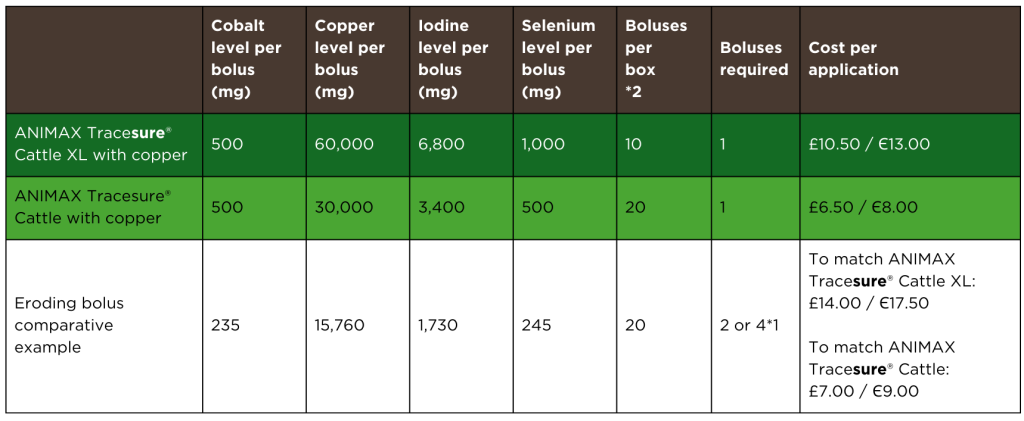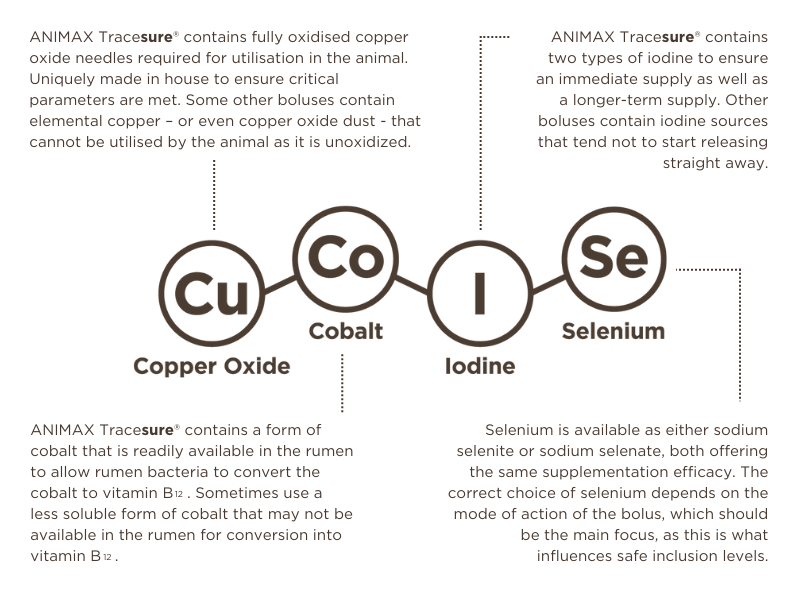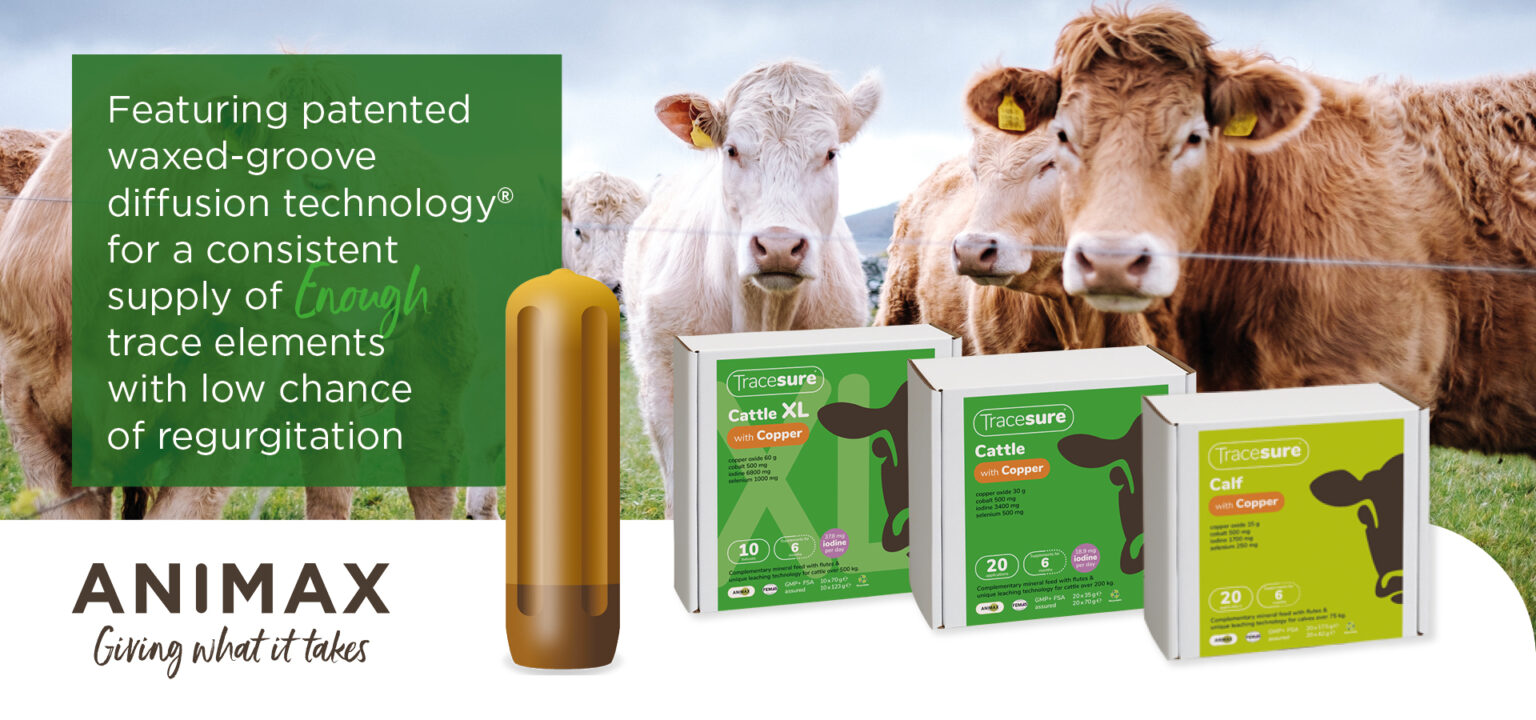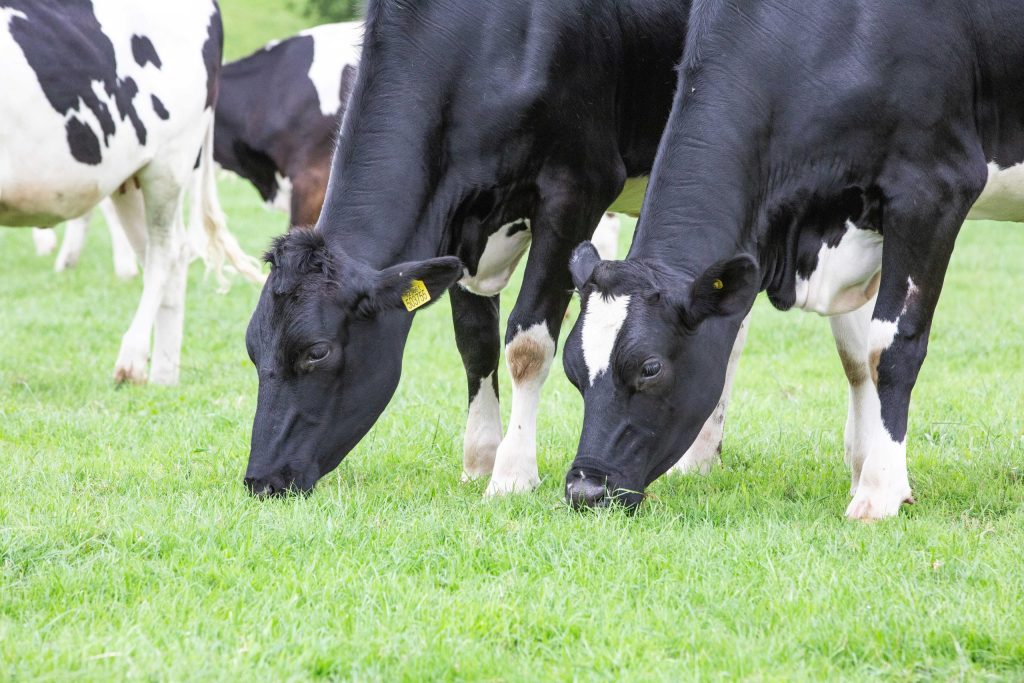The roles of trace elements in cattle
Trace elements are vital for cows to capture and use the energy and protein, as well as supporting other critical biological functions.
| Lifecycle stage | Critical functions influenced by trace elements |
| Transition cows and in-calf sucklers | Foetal development, colostrum production, and metabolic health, for example, risk of retained placenta. |
| Lactating cows and sucklers | Milk production, pregnancy, immune responses to a range of challenges including mastitis, and reproductive health. |
| Dairy replacements and suckler calves | Immune response to wide range of conditions. Daily liveweight gain rates, fertility. |
The trace element ‘dilution effect’ turnout conundrum
Grass protein and energy levels are at their highest in the spring. Whilst energy and protein are the most significant ingredients to cattle growth and healthy production, they need to be in balance with trace elements and vitamins.
Problem 1: Grass can be abundant in protein and energy but can be deficient in minerals. If grass is growing rapidly, trace element levels are diluted.
Problem 2: Furthering this issue is the fact that spring grass tends to get contaminated with soil depending on the weather and poaching – and the way the weather is this year this is certainly going to be the case. Typically, cattle commonly ingest soil at a rate up to 18% of their dry matter intake. However, this can go up to 30% when soil splash is high (Source: National Library of Medicine). While in theory this can mean a greater intake of trace elements, often there are high levels of antagonists in the soil which can interact with trace element availability. One example is copper which can be ‘bound’ by thiomolybdate complexes formed by the molybdenum as well as iron present in the soil and sulfur either in the soil or plant proteins.
Problem 3: If trace element deficiencies are known, we must stay ahead of that deficiency to improve performance. The challenge is that it’s difficult to balance grass with supplements when cows already have a belly full of grass. When cows go out, all they want to do is eat grass, and they have less interest in eating buffer or in-parlour feeds. It’s like she’s been on salad all winter and now has a big bowl of sweets in front of her!
IMPORTANT!
Don’t supplement to correct a problem, supplement to stop the problem from occurring in the first place! This is where bolusing comes into play. By offering a trace element bolus before turnout, you can be rest-assured they will have a daily supply of the essential trace elements for sustained periods.
When cows move from winter rations to spring and then summer grass, the rumen is exposed to grazing variability and grass composition inconsistencies. Not good news for the rumen, which loves and needs consistency, and dislikes rapid changes. Adding to this, spring grass tends to be low in fibre and high in sugar, furthering the disturbance to rumen pH. If rumen pH is not balanced, grass will pass through the digestive system too quickly, increasing the risk of acidosis and reducing the energy captured.
Watch out for grass staggers / tetany (hypomagnesemia)
Grass – particularly during spring turnout when fast-growing – tends to be deficient in magnesium. There are also various factors that can impact the animals ability to absorb it when supplied, and lactating cows are most susceptible to deficiency. Magnesium is an essential macro nutrient for the skeletal, nervous, and metabolic systems. With 1 in 100 UK cattle experiencing clinical grass staggers (Source: NADIS), and a much higher proportion experiencing sub-clinical issues, the deficiency is a very real threat and can even lead to cow mortality.
Mostly stored in the bones, magnesium is not readily-available, and so is required at the right levels in the diet all the time. Aside from ensuring cattle take in adequate fibrous dry matter, animals must be offered a balanced diet with enough supplementation of magnesium alongside other essential nutrients. Ideally, supplementation should start 2-weeks before turning out.
Watch out for milk fever (hypocalcaemia)
At the very beginning of a cow’s lactation, when there is a sudden and sharp (3X) increase in calcium excretion, blood calcium can drop to a critically low level. This can impact the nervous system and cause muscle weakness; hence more severe milk fever can result in cows unable to get up and even lose consciousness. Milk fever effect cows of any age but is most common in 3rd to 5th lactation dairy cows that are high-producing at the onset of calving and up to 3 days after. According to the Farm Advisory Service, clinical cases of milk fever cost the farm business approximately £200–250. This cost includes treatment costs, increased risks of other disease, milk production impacts, and future fertility challenges.
As always, the target is to prevent rather than cure. An oral calcium supplement such as ANIMAX EasyCal+ Cattle, can be given around calving time and repeated every 12-15 hours as required. It is rapidly absorbed into the bloodstream to counteract the calcium excretion.
Some farms are wholly dependent on grass, whilst others are accustomed to supplementation with various feed materials. Energy is usually balanced with cereals, digestible fibre (such as soya hulls, citrus, and sugar beet pulp), and/or rumen-protected fat. But that is a whole topic itself, and down to the on-farm nutritionist who weighs up all the variable factors involved.
What we’re focussing on here is the role of trace elements to balance the grass and any supplementary feeds provided during turnout. Trace elements – specifically cobalt, copper, iodine, and selenium – are essential to not just the rumen, but the entire digestive system function and metabolism regulation.
Trace element roles in fertility
- Cobalt deficiency can manifest as a marked reduction in conception rates, and therefore, an increase in calving intervals.
- Copper deficiency in the liver is associated with female reproductive disorders, the most common being prenatal mortality and particularly early embryonic loss. Most commonly associated with poor (orange-coloured) coat condition. Most dairy cows actually have too much copper through their diets, emphasising the importance of analysing the diet to ensure the correct supply is enough.
- Iodine deficiency, which presents itself similarly to iodine overload, is associated with impaired thyroid function and homeostasis, which can impact on submission rates, and contribute to cases of retained placenta, abortion, stillbirth, and/or weak calves.
- Selenium deficiency is associated with reduced fertility, embryonic or foetal loss, and/or weak and sickly calves.
Trace element roles in growth
- Cobalt deficiency can be associated with compromised metabolic function.
- Copper deficiency can be associated with impaired oestrous cycles.
- Iodine deficiency can be associated with irregulated metabolism.
- Selenium deficiency can be associated with compromised immunity.
Doing the math: How different boluses stack-up at turnout

*1 Giving 4 boluses to one animal is NOT RECOMMENDED but would be required to match the levels in one ANIMAX Tracesure® Cattle XL with copper bolus application.
*2 When reading the label, it is important to consider any differences between the number of boluses and the number of applications. So, for example, the box may state 10 boluses, but each cow requires a double dosage, which means only 5 total applications.
ANIMAX Tracesure® offers optimal levels of trace elements to satisfy the demands of the growing or reproducing animal. However, quality is as important as quantity. Some sources and forms offer greater bioavailability (are more absorbable and utilisable by the animal) than others.

Handy hints for turnout:
1. If you have not already done a soil or forage analysis, do one before turnout
2. Make sure you bolus in good time before they go out, ideally 4-6 weeks before turnout
3. Check out AHDB’s resource library for more information on these other important management factors such as parasite and disease control, as well as soil, grass, and grazing management



